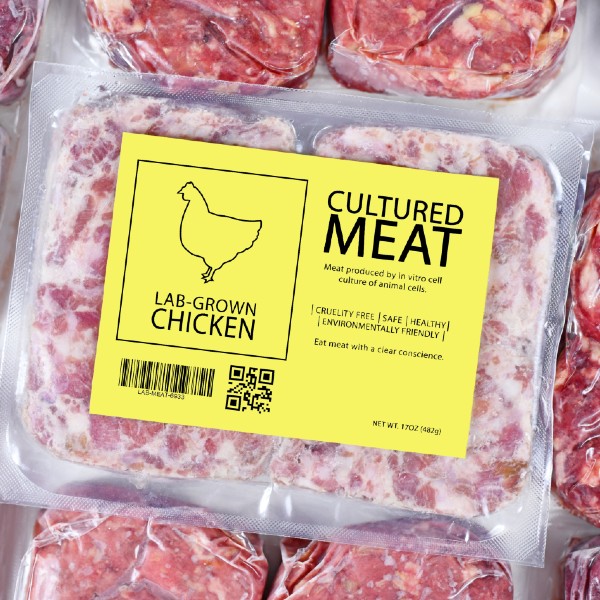Watch our recent talk at the 2021 Industrializing Cell-Based Meats and Seafood Summit. Watch Now >>
“New cell-based meat technology is redefining our ideas around diet, agriculture, manufacturing, and business.”
Fueled by population growth and economic development, the global demand for meat is expected to grow by 70% through 2050. Traditional approaches to simply “scale-up” production of livestock, fish, poultry, and other meat provide insufficient incremental increases and have a growing negative impact on the environment and animal welfare. To avoid the impending food security emergency, researchers are adopting a new approach to solve the problem. Instead of devising ways to grow more animals, they deconstructed the idea of meat into its fundamental biochemical elements. After all, in all its forms, food is simply a mixture of tissues delivering the nutrients and sensory stimuli we are accustomed to.
New cultured meat technology is redefining our ideas around diet, agriculture, manufacturing, and business. In the case of meat, scientists have begun to grow animal cells in vitro to cultivate enough cells, which, when combined with other biochemicals, can replicate the taste, appearance, texture, and nutritional value of meat. In this case, the cells, not the animals, are the units of the meat product. Therefore, the grown cells build the animal meat instead of harvesting meat from the animal. So how do scientists do this?

First, a small biopsy of cells is obtained from the animal. The small biopsy eliminates the need for the animal to be slaughtered. Alternatively, cell lines that provide the desired characteristics can be developed and baked for a more sustainable and scalable approach. The cells from the biopsy are then transferred to a sterile vessel like a flask or bioreactor for growth. The type of vessel depends on the cell type, desired product to be produced, and the intended manufacturing scale of the process. The cells are then fed a nutrient-rich cell culture media composed of various components (e.g., amino acids, sugars, fats, water, salts, growth factors, and trace minerals). And just like the vessel type, the cell culture media formulation may be particular to the kind of cells and process. Therefore, researchers cannot rely on a one-size-fits-all approach to cell culture media to obtain the highest yield for a specific cell type.
As the cells from the biopsy are grown in the vessel and are fed the media, they proliferate and differentiate into suitable cell types for consumption (e.g., muscle, fat, or connective tissue cells). Also, depending on the vessel or cell line, adding a scaffold to provide a supportive structure for the cells may be required. Similar to vessel types and cell culture media composition, scaffolds can be constructed using various approaches (e.g., 3D printing, electrical stimulation, electrospinning, etc.) and different materials (e.g., collagen, fibronectin, hydrogels, mycelium, etc.).
Despite the scientific and manufacturing complexity of cultivating meat, more than 70 start-ups have focused on manufacturing cultured meat products, with more than 40 Life Science companies announcing that they will help supply and support the industry. Additionally, in 2020 $3.1 billion was invested in the alternative protein industry, with more than 10% devoted to cultivated meat companies. That total is roughly three-quarters of the total amount raised from 2016-2020 combined. And, although there is yet to be a company to reach commercial-scale production, the first cultivated meat product was released for sale in December 2020 in Singapore. Excitement and momentum are being built on biological breakthroughs that set the stage to support this industry.
The urgency of this important work
Four of the most cited reasons to pursue alternatives to traditional livestock meat production are (1) the limited arable land available for livestock feeding and management, (2) the environmental impacts of livestock production, (3) concerns over animal wellbeing, and (4) public health risks related to foodborne pathogens and emerging diseases. Concerning the first two points, it is estimated that 1 kg of beef production requires 15,000 L of water and 40 m2 of land and produces approximately 300 kg of CO2 equivalents. Cultured meat aims to drastically decrease the environmental burdens of traditional meat production. Still, until it is successfully scaled, we only have predictions and estimates of its total benefit to the environment.
As to the third and fourth reasons, cultured meat production mitigates concerns about animal welfare and human health risks associated with eating meat. Needless to say, traditional meat production relies on the continued suffering and slaughter of animals. As to human wellbeing, the possibility of foodborne illness from pathogens or zoonotic diseases is a known safety risk of the traditional livestock industry. Because it is produced in a laboratory from screened tissue biopsy samples, cultured meat relies on clean processes that do not harm animals and can effectively screen raw material inputs to significantly lower the risk of foodborne illnesses.
Over the next series of articles, we will be taking a closer look at some of the latest research in this exciting field of cultivated meat production.
Cell-Based Meat Process Development Series
- Part 1: An Introduction to the Cell-Based Meat Revolution
- Part 2: The Variety of Process Considerations in Cell-Based Meat Production
- Part 3: How Cell Proliferation for Cultured Meat Production Relies on the Appropriate Microcarrier or Scaffold Selection
- Part 4: The Importance of Cell Culture Media Optimization for Cost and Productivity Considerations in Cell-Based Meat Processes
- Part 5: The Role of Analytics in Cell-Based Meat Production
Subscribe to Our Communications
Signup to receive new product updates, technical tips and more.
